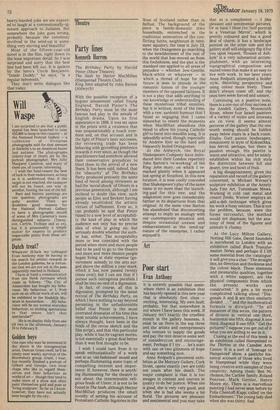Art
Poor start
Evan Anthony
It is entirely possible that somewhere there is an exhibition that has bravely opened in this new year that is absolutely first class — exciting, interesting. My own fault, probably, but that somewhere is not where I have been this week. If January isn't exactly the cruellest month in the gallery business, it must be up there in the top three and the artists and entrepreneurs who venture to supply the goods and pay the rent deserve some sort of consideration and encouragement. Perhaps if I try .. . let's start with one or two glimmers of hope and say something nice.
Anne Redpath's piecemeal exhibition at the Mercury Gallery, Cork Street, opens exactly (we are told) ten years after her death. The major complaint is that it is too meagre in content and uneven in quality to do her justice. When she is good, she is very very good, and when she is bad she seems a bit florid. The pictures are pleasant and sentimental and you may take that as a compliment — I like pleasant and sentimental pictures. Or at least 1 liked the `Self-portrait in a Venetian Mirror', which is prettily coloured and has a good deal of charm; it has a landscape painted on the other side and the gallery staff will obligingly flip it for you upon request, 'Houses at Ashkirk' is a very substantial accomplishment, with an interesting topographical composition and muted tones that make it an easy to live with work. In her later years Anne Redpath attempted a bolder style, distorting perspective and using colour more freely. These didn't always come off, and the ones here seem forced and unsure.
Continuing on a positive note, there is a one-out-of-four success at the Ansdell Gallery, Monmouth Street, where four Israeli painters of a variety of styles and interests are on view. It seems almost perverse of the gallery that the one worth seeing should be hidden away below stairs in a back room. Eliahu Gatt paints landscapes, reminiscent in style of Kokoschka, less fervid, perhaps, but there is passion enough. His palette is warm and attractive, and he neatly establishes within his rich style the distinction between hill and desert, tree and bowl of fruit.
A big disappointment, given the reputation and record of the gallery concerned, is Michael Werner's sculpture exhibition at the Annely Juda Fine Art, Tottenham Mews. Working in cold cast metal and ciment fondu, Werner employs an add-a-dab technique which gives his work a fussy texture. This is not the problem, because, were the forms successful, the method would not displease; but the anatomy of most of the figures and animals is clumsy.
At the Lucy Milton Gallery, Notting Hill Gate, David Saunders is introduced to London with an exhibition called Black Transformation Series and perhaps if I lift some material from the 'catalogue' it will give you a clue: "The straight line, its direction and thickness and the colour black. These elements and measurable qualities, together with a white support, are the physical components from which the present works are constructed." It gets a bit more complicated talking about "Diagonals A and B are then similarly divided ... " and the mathematical formula is divulged: "In all instances of this series, the pattern of division is: vertical one third, horizontal one fifth, diagonal A one third, diagonal B one fifth." Get the pictures? I suppose you get out of it what you are willing to see in it.
Closing at the end of this week is an exhibition called Hampstead in the Thirties at the Camden Arts Centre. It is a sort of 'homage to Hampstead' show, a pastiche historical account of those who lived in Hampstead while they were being creative with samples of their creativity. Among them: Ben Nicholson, the Carline family, Roland Penrose, Mark Gertler, Henry Moore etc. There is a marvellous painting I had never seen before by Polia Chentoff-Kapp, called 'on the Embankment.' The young lady died when she was thirty. Sad.


































 Previous page
Previous page